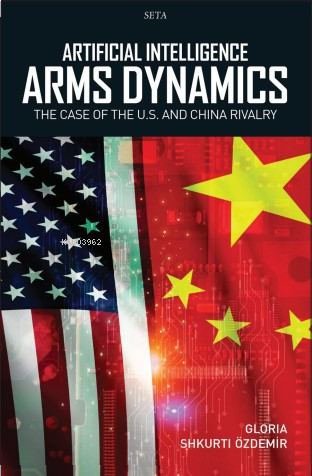9786256583597
846891

https://www.davudkitap.com/artificial-intelligence-arms-dynamics-the-case-of-the-u-s-and-china-rivalry
Artificial Intelligence Arms Dynamics;The Case Of The U.S. And China Rivalry
450.00
Artificial Intelligence (AI) has undergone rapid evolu- establish its leadership in AI technology by 2030, chal- tion, not only by penetrating every aspect of our life but also lenging U.S. dominance and reshaping the global secu- by transitioning from theoretical concepts to foundational rity landscape. components of modern military strategy. This book focuses The analysis reveals that rather than an AI arms race into the heart of this evolution, focusing on the escalating where the possibility for warfare should be high, the rivalry AI arms rivalry between the U.S. and China. Drawing upon between U.S.-China is more an “AI arms competition” with Barry Buzan's theoretical frameworks, this book aims to ana- both states not willing to start a direct war with each other, lyze if there is an AI arms race between the U.S. and China as at least for the short term. Furthermore, the study finds out a part of the ongoing great power competition. that the AI arms competition between both states is driven Findings from the study indicate that both countries by both external threats and internal motivations, how- perceive AI as a pivotal element of future warfare and ever, the technological imperative -which is considered as national security, leading to significant investments in an independent variable- is the main driving force behind research and development. The U.S., with its historically this rivalry. In conclusion, the research suggests that the AI dominant military-technological edge, seeks to maintain arms competition between the U.S. and China is a defining its superiority through innovation and strategic partner- feature of contemporary international security dynamics, ships. Conversely, China's ambitious AI strategy aims to with profound implications for global stability.
Artificial Intelligence (AI) has undergone rapid evolu- establish its leadership in AI technology by 2030, chal- tion, not only by penetrating every aspect of our life but also lenging U.S. dominance and reshaping the global secu- by transitioning from theoretical concepts to foundational rity landscape. components of modern military strategy. This book focuses The analysis reveals that rather than an AI arms race into the heart of this evolution, focusing on the escalating where the possibility for warfare should be high, the rivalry AI arms rivalry between the U.S. and China. Drawing upon between U.S.-China is more an “AI arms competition” with Barry Buzan's theoretical frameworks, this book aims to ana- both states not willing to start a direct war with each other, lyze if there is an AI arms race between the U.S. and China as at least for the short term. Furthermore, the study finds out a part of the ongoing great power competition. that the AI arms competition between both states is driven Findings from the study indicate that both countries by both external threats and internal motivations, how- perceive AI as a pivotal element of future warfare and ever, the technological imperative -which is considered as national security, leading to significant investments in an independent variable- is the main driving force behind research and development. The U.S., with its historically this rivalry. In conclusion, the research suggests that the AI dominant military-technological edge, seeks to maintain arms competition between the U.S. and China is a defining its superiority through innovation and strategic partner- feature of contemporary international security dynamics, ships. Conversely, China's ambitious AI strategy aims to with profound implications for global stability.
Axess Kartlar
| Taksit Sayısı | Taksit tutarı | Genel Toplam |
|---|---|---|
| Tek Çekim | 450,00 | 450,00 |
| 2 | 234,00 | 468,00 |
| 3 | 159,00 | 477,00 |
| 6 | 81,00 | 486,00 |
| 9 | 55,00 | 495,00 |
QNB Finansbank Kartları
| Taksit Sayısı | Taksit tutarı | Genel Toplam |
|---|---|---|
| Tek Çekim | 450,00 | 450,00 |
| 2 | 234,00 | 468,00 |
| 3 | 159,00 | 477,00 |
| 6 | 81,00 | 486,00 |
| 9 | 55,00 | 495,00 |
Bonus Kartlar
| Taksit Sayısı | Taksit tutarı | Genel Toplam |
|---|---|---|
| Tek Çekim | 450,00 | 450,00 |
| 2 | 234,00 | 468,00 |
| 3 | 159,00 | 477,00 |
| 6 | 81,00 | 486,00 |
| 9 | 55,00 | 495,00 |
Paraf Kartlar
| Taksit Sayısı | Taksit tutarı | Genel Toplam |
|---|---|---|
| Tek Çekim | 450,00 | 450,00 |
| 2 | 234,00 | 468,00 |
| 3 | 159,00 | 477,00 |
| 6 | 81,00 | 486,00 |
| 9 | 55,00 | 495,00 |
Maximum Kartlar
| Taksit Sayısı | Taksit tutarı | Genel Toplam |
|---|---|---|
| Tek Çekim | 450,00 | 450,00 |
| 2 | 234,00 | 468,00 |
| 3 | 159,00 | 477,00 |
| 6 | 81,00 | 486,00 |
| 9 | 55,00 | 495,00 |
World Kartlar
| Taksit Sayısı | Taksit tutarı | Genel Toplam |
|---|---|---|
| Tek Çekim | 450,00 | 450,00 |
| 2 | 234,00 | 468,00 |
| 3 | 159,00 | 477,00 |
| 6 | 81,00 | 486,00 |
| 9 | 55,00 | 495,00 |
Diğer Kartlar
| Taksit Sayısı | Taksit tutarı | Genel Toplam |
|---|---|---|
| Tek Çekim | 450,00 | 450,00 |
| 2 | - | - |
| 3 | - | - |
| 6 | - | - |
| 9 | - | - |
Yorum yaz
Bu kitabı henüz kimse eleştirmemiş.










